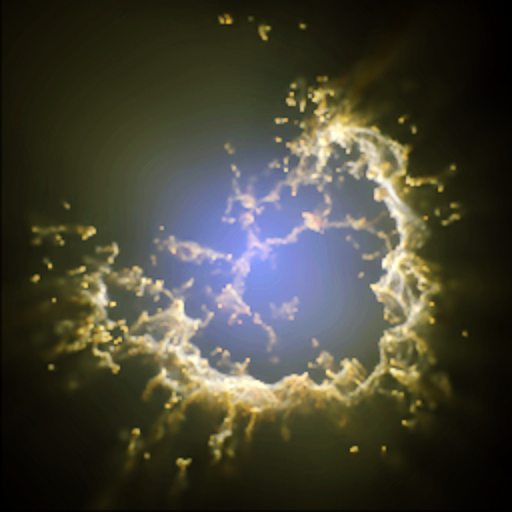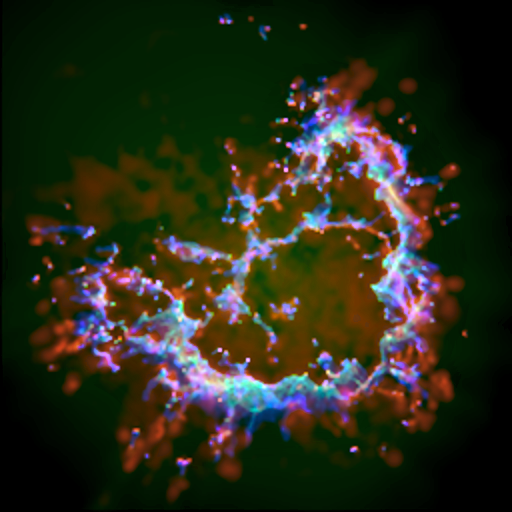Blasted by radiation
Stars are born from the collapse of the gas and that pervades the space between the stars. Astrophysicists call it the “interstellar medium” (ISM). Much of the ISM is invisible to the naked eye and it mostly consists of hydrogen. Important parts of the ISM, however, are visible only by raditelescopes and large interferometers, such as ALMA, and becomes visible also to the optical wavelengths when it interacts with radiation. The formation of spectacular nebulae is one such case in which ultraviolet photons emitted by nearby massive stars (ten to twenty times more massive than our Sun) ionise parts of the ISM creating what astrophysicists call "HII regions" (pronounced as "H two", ionised). Nebulae are a very frequent target for astrophotography from amateur astronomers all over the world.

Fig. 1: Composite dust emission of the expanding shell. The massive star, which drives the expansion is 10 000 times more luminous than our Sun. Blue indicates the warm, low density dust λb = 70 μm, 50 K < Tdust < 100 K, green shows the cool dust (λg = 250 μm, Tdust ≤ 30 K), while red indicates the overall dust density (λr = 1300 μm). The diameter of the cloud is 12 parsec (1 pc = 3.09×1013 km).

Fig. 2: Dust, carbon monoxide (CO) and ionized carbon (C+) emission of the nebula. The 1300 μm dust emission is coloured green, indicating the density frame of the shell. The ionized gas (C+ in red) fills the cavity created by the young, high mass star and tracing a thin layer around dense structures. The molecular interior of dense filamentary structures are traced by the CO emission in blue colour.
Using the Smoothed Particle Hydrodynamics code SEREN (Hubber et al. 2011; Bisbas et al. 2009), the astrochemical code 3D-PDR (Bisbas et al. 2012) and the radiative transfer code RADMC-3D (Dullemond 2012, see Szűcs et al. 2014 for application) we have re-created a fractal nebula (Walch et al. 2012) in our computer. The video below shows the evolution of the 10 000 Solar mass cloud, starting from the formation of the massive, luminous giant star in its centre. The radiation pressure and the heat deposited by the ultraviolet radiation of the star, which is 10 000 times stronger than that ouf our own Sun, expells the initially quitescent cloud, and forms the HII region. Due to the initially patchy cloud structure, the expansion is not symmetric; the resulting complex, three-dimensional structure is also illustrated at the end of the video.
The density structure of HII regions, as shown in the video, cannot be directly determined from observation. Astronomers are restricted to the measurement of light, emitted by molecules and dust grains in the cloud. The occurence and light emiting ability of these, however, is a complicated function of the density, the environment and the radiation from other parts of the cloud. The combination of hydrodynamic simulations with a computer model for the propagation of light gives us the chance for an in depth study of the physical and chemical processes, that are governing this interaction. The theoretical predictions of this model can be directly compared with real observations. The nebula here is very reminiscent of the RCW 120 as observed by the Spitzer (link) and the Herschel (link) space telescopes. As the hot medium at the interior of the nebula expands (blue in Fig. 1), it creates a strong shock front of dense material (red and turquoise in Fig. 2) which can then further collapse under it's own gravity (self-gravity) creating new stars, a process called "triggered star formation".
